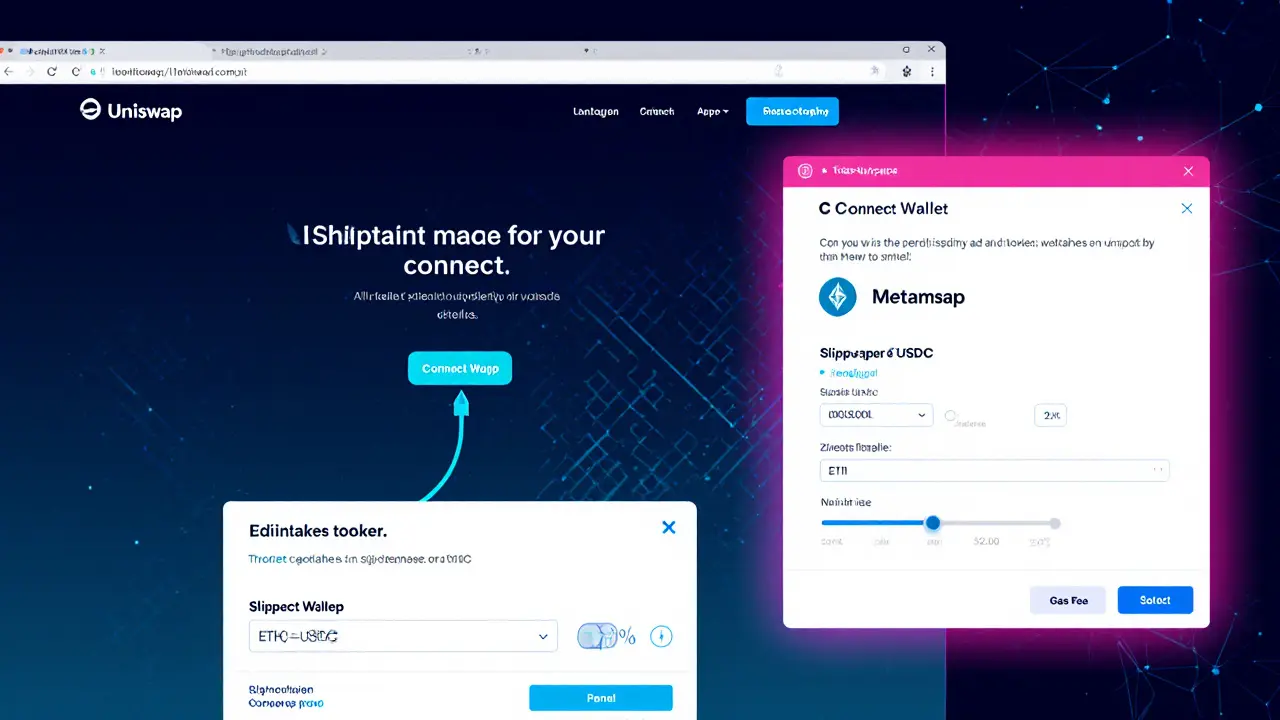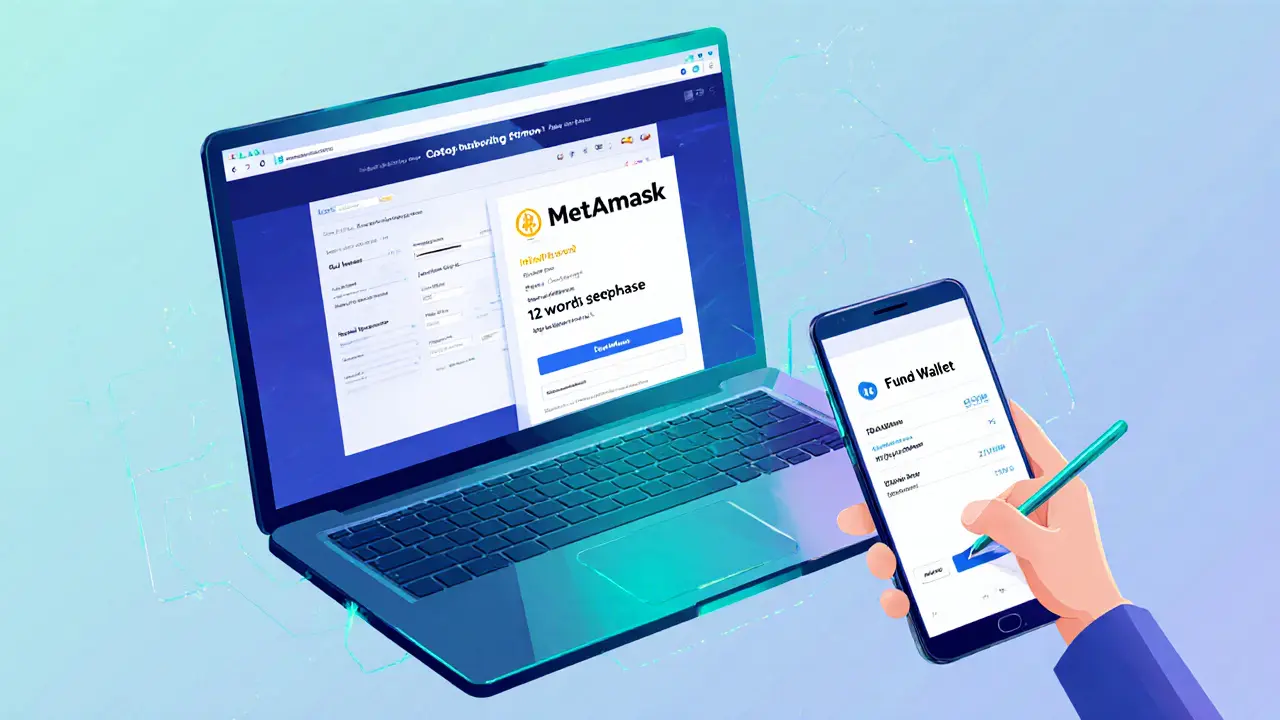Gas Fee Estimator for DEX Transactions
Estimated Gas Fee
Quick Takeaways
- Choose a Web3‑compatible wallet (MetaMask, Coinbase Wallet, Trust Wallet) and fund it with the native token for gas.
- Connect your wallet to a DEX (Uniswap, Curve, PancakeSwap) via the website’s "Connect" button.
- Set slippage tolerance (1‑3% is a safe starter) and approve the token before swapping.
- Watch gas fees: Ethereum can cost $1‑$5 for small trades, while Layer‑2s or Solana drop below $0.01.
- If you plan to provide liquidity, understand impermanent loss and concentrate liquidity ranges.
Trading crypto without a middleman feels futuristic, but the steps are surprisingly simple once you get the basics down. Below is a practical walk‑through that takes you from a brand‑new wallet to a successful token swap on a modern decentralized exchange a peer‑to‑peer platform that uses smart contracts to match trades directly from users’ wallets. We’ll also cover common hiccups-like gas‑fee surprises and slippage errors-so you can troubleshoot on the fly.
1. Set Up a Web3‑Compatible Wallet
The first job is to have a wallet that can speak the language of DEXs. The most popular choice is MetaMask a browser extension and mobile app that lets you manage Ethereum‑compatible private keys, but Coinbase Wallet and Trust Wallet work just as well.
- Install: Download the extension or app; the onboarding flow usually finishes in under two minutes.
- Secure: Write down the 12‑word seed phrase on paper, store it offline.
- Fund: Send a small amount of the native blockchain token (e.g., ETH for Ethereum, BNB for BNB Chain). For a first trade on Ethereum, 0.02ETH (≈$4) covers most gas costs.
2. Choose the Right DEX for Your Trade
Not all DEXs are created equal. Uniswap an automated market maker (AMM) on Ethereum that hosts hundreds of thousands of token pairs dominates Ethereum volume, while Curve excels at stablecoin swaps and PancakeSwap leads on BNB Chain. Your choice depends on three factors:
- Blockchain: Ethereum has higher fees but broad token coverage; BNB Chain and Polygon are cheaper.
- Liquidity: Higher liquidity reduces slippage. Check the pool size on the DEX interface.
- Feature set: Some DEXs offer limit orders (via aggregators) while others are pure swaps.
3. Connect Your Wallet to the DEX
Once you land on the DEX website (e.g., uniswap.org), look for the "Connect Wallet" button. Click it, select your wallet type, and approve the connection in the wallet extension. The whole process averages about 15 seconds for seasoned users.

4. Pick the Token Pair and Set Slippage
Now you choose what you’re swapping. Suppose you want to trade ETH for USDC. Select the two tokens from the dropdown menus. Next, set a slippage tolerance. Slippage is the price movement that can happen between the moment you submit the transaction and when it’s mined. Most guides recommend starting with 1‑3% on Ethereum; on low‑volatility pairs you can drop it to 0.5%.
5. Approve the Token (If Required)
For ERC‑20 tokens, the DEX needs permission to move the token on your behalf. This triggers an "Approve" transaction, which costs a small amount of gas. Once approved, the token can be swapped repeatedly without another approval-unless you revoke it later.
6. Execute the Swap
Press the "Swap" button, confirm the details (amount, price impact, fee), and hit "Confirm" in your wallet. On Ethereum, the transaction typically confirms in 15‑30 seconds; on Solana it can be sub‑second. After confirmation, you’ll receive a transaction hash you can view on a block explorer (Etherscan for Ethereum, Solscan for Solana).
7. Verify the Transaction and Manage Your Assets
Open the block explorer link provided by your wallet to see the exact gas used and final price. If the price impact looks too high, you can revert the trade (if the token still exists) or simply accept the loss-unfortunately DEXs lack stop‑loss orders.
8. Common Pitfalls and How to Fix Them
- Insufficient gas: The error shows up in 22% of first‑time attempts. Always keep a buffer of native tokens-about 0.03ETH for a typical swap.
- Slippage exceeded: Reduce the tolerance only if the market is stable; otherwise increase it to avoid failed trades.
- High fees on Ethereum: Switch to a Layer‑2 like Arbitrum or Optimism, where fees drop by 80‑90% (Nikhilesh De, CoinDesk, 2024).
- Impermanent loss (if providing liquidity): Use concentrated liquidity ranges (Uniswap V3) and monitor price movements; a 20% volatility can erode 5‑6% of your capital over a month.
9. Quick Comparison: DEX vs. Centralized Exchange
| Aspect | Decentralized Exchange | Centralized Exchange |
|---|---|---|
| Custody | Non‑custodial; you control private keys | Custodial; exchange holds your keys |
| KYC Requirement | None (privacy‑preserving) | Mandatory for most platforms |
| Typical Fees | 0.3% trading fee + gas (≈$1‑$5 on Ethereum) | 0.20‑0.60% trading fee, no gas |
| Liquidity Depth | Varies by pool; top DEXs hold $64B TVL (Q22024) | Higher on popular pairs, but limited to listed assets |
| Speed | 15‑30s on Ethereum, sub‑second on Solana | Instant (off‑chain matching) |
| Support | Community‑driven, limited official help | 24/7 customer service |
10. Next Steps: From Swapper to Liquidity Provider
If you’re comfortable swapping, the natural progression is to add liquidity. Pick a pool on Uniswap V3, set a price range you’re confident about, and deposit equal values of the two tokens. Remember, you’ll earn a portion of the 0.05‑0.30% pool fee, but you also expose yourself to impermanent loss. Many traders start with stablecoin pairs (USDC/DAI) where price variance is minimal.
Frequently Asked Questions
Do I need to verify my identity to use a DEX?
No. DEXs are built to be permissionless. You only need a wallet and some native tokens for gas.
Why is my transaction failing on Ethereum?
Common reasons are insufficient gas, slippage set too low, or network congestion. Increase your gas limit and adjust slippage to 2‑3% for volatile pairs.
Are DEX fees higher than CEX fees?
On Ethereum the gas cost can make a small trade expensive, but Layer‑2 solutions bring fees down to well under $0.01, making DEXs competitive with most centralized fees.
Can I trade directly from a hardware wallet?
Yes. Ledger and Trezor integrate with MetaMask and other Web3 browsers, letting you sign DEX swaps without exposing private keys to your computer.
What is “impermanent loss” and should I worry about it?
Impermanent loss occurs when the price ratio of the two tokens in a liquidity pool changes. It’s a real risk for LPs, especially in volatile markets. Using concentrated liquidity or stablecoin pools can mitigate it.


1 Responses
Nice walkthrough, really breaks down the whole DEX flow without overwhelming anyone. If you’re just starting, set up MetaMask first and grab a little ETH for gas-no need to buy a ton right away. Keep an eye on slippage and you’ll be good to go.